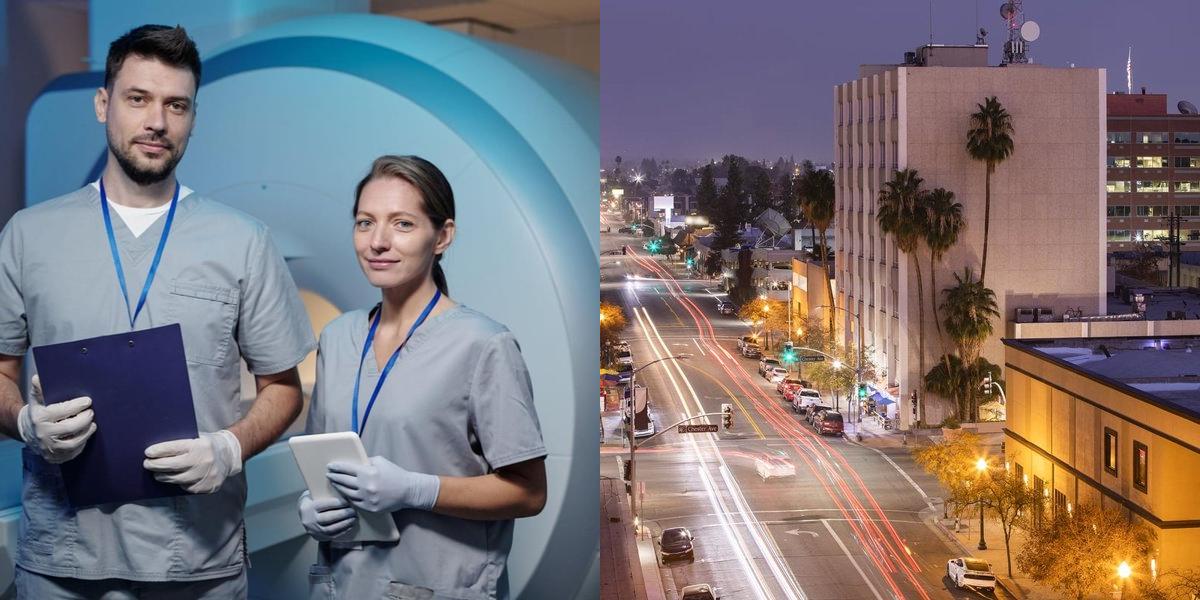How to Become a Radiology Technician in California

To become a radiology technician in California, you’ll need to complete an accredited radiologic technology program, earn ARRT certification, and apply for a state license through the California Department of Public Health (CDPH).
According to the U.S. Bureau of Labor Statistics (BLS), radiologic technologists and technicians in California earn an average of $112,120 per year ($53.91 per hour), among the highest in the nation.
Dreambound helps you find accredited radiology tech programs in California so you can begin training and start your healthcare career.
Radiology Technician Programs in California
Accredited radiology technician programs in California must be approved by JRCERT and meet CDPH licensing standards.
If you’re exploring options, Dreambound lists radiology tech schools in California where you can compare accredited programs by city:
- Radiology Technician classes near me in Los Angeles
- Radiology Technician classes near me in Oxnard
- Radiology Technician classes near me in Sacramento
- Radiology Technician classes near me in San Diego
- Radiology Technician classes near me in San Jose
- Radiology Technician classes near me in Stockton
Browse accredited radiology tech programs in California on Dreambound and find a school that matches your location and schedule.
Radiology Technician Certification and Licensing Requirements in California
To work legally, you need both national certification and a radiology technician license in California.
Certification
- Pass the ARRT certification exam
- Apply to the CDPH Radiologic Health Branch (RHB) for your state license
- Employers typically require proof of both credentials before hiring
Maintaining Your Certification and License
To stay certified and licensed in California, you’ll need to renew both your ARRT credential and state license regularly.
- Renew your certification annually by the end of your birth month through your online ARRT account.
- If you miss the deadline, your certification will be discontinued.
- Renewal fees:
- $30 for your first discipline
- $15 for each additional
- $45 if certified via ARDMS or NMTCB
- Starting 2026: flat $65 fee for all registrants
Continuing Education (CE)
- Every two years, complete 24 CE credits to stay compliant.
- Use ARRT’s CE tools to find eligible activities.
- Missing CE deadlines could place you on CE probation.
State License Renewal
- California requires a separate renewal through the Radiologic Health Branch (RHB), which includes a fee and verification of CE completion.
Tip: Set calendar reminders for both ARRT and state deadlines to keep your credentials active and avoid penalties.
Skills and Qualities of a Good Radiology Tech
Strong radiology tech professionals combine technical knowledge with patient-care skills.
Important qualities include:
- Attention to detail and precision
- Communication and empathy with patients
- Knowledge of radiation safety protocols
- Comfort with digital imaging equipment
- Ability to work in fast-paced clinical settings
Job Outlook for Radiology Technicians
According to the BLS Occupational Outlook Handbook, employment of radiologic technologists and technicians is projected to grow 4% from 2024 to 2034, about as fast as the average for all occupations.
California’s large hospital and outpatient network offers many radiology tech jobs in California, with continued demand in imaging and diagnostics.
Frequently Asked Questions
What is the quickest way to become a radiology tech?
Choose an accelerated or hybrid radiologic technology program (about 18 months) that prepares you directly for the ARRT exam.
What do you need to be a radiology technician in California?
You need to complete a CDPH-approved program, pass the ARRT exam, and obtain a state license.
Are there online radiology tech programs in California?
Some schools offer hybrid formats combining online coursework with in-person labs and clinical rotations. See Dreambound for options.
Do radiology techs need a license in California?
Yes. All radiologic technologists must hold a valid radiology technician license in California issued by the CDPH-RHB.
Final Thoughts
Becoming a radiology technician in California typically takes about two years, but it leads to a stable, high-paying career in medical imaging. With proper training, certification, and licensing, you’ll play a vital role in patient care and diagnostics.
Compare accredited radiology tech programs in California on Dreambound and take your next step toward a rewarding career today.
Related Guides

Athena is Co-founder and CEO of Dreambound.





